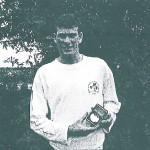When someone tells you that his or her sport is rowing you might conjure up a vision of a small wooden boat paddling up the Corrib on a nice Summer’s day, and wonder where is the challenge in that. Or you might think of the currachs in Kinvarra during the Cruinniú na mBád festival. Or you might, perhaps, consider the recent exploits of Steve Redgrave, arguably the greatest Olympian of all time, and of the legendary Emmets oarsmen from Menlo back in the 1930s.
Then you might think that rowing is a sport for the city folk, or is in some way an exclusive pursuit. You might even think that it is not in the gaelic tradition. Not so. The Tailtean Games in the 1930s—a celebration of Gaelic sports—included rowing as one of the key events, and the villagers of Menlo took it to their hearts and excelled in winning the Irish Senior championship in 1929 and 1931.
There are five rowing clubs in Galway, and about eighty throughout Ireland. The local clubs are of the secondary schools, the Bish and the Jes, from NUIG, and the two commercial or non-institutional clubs, Tribesmen Rowing Club and Galway Rowing Club. Corrib, Commercial, the Royal, the Hibernian, Emmets and others are, sadly no longer active today.
The rowing outrigger is so called because the point at which the oar is attached to the boat is via an aluminium rig, which reaches well outside the hull of the boat. This is necessary because the boat is so narrow that the oar could not effectively connect directly to the hull. The boats, which cater for 8, 4, 2 or 1 rower can be up to 60 ft (20m) long, and no more than 18” wide. The boats are generally of a very sophisticated construction, with the hulls made from a plastic skin internally and externally, with a honeycomb material between. Fixtures and fittings may be of aluminium, timber plastic, carbon fibre or combinations of all of these. Oars are no longer of a wooden construction but are lightweight carbon-fibre constructs.
Because these boats use a sliding seat, most of the power comes from the rower’s legs rather than the arms and shoulders as might often be assumed. Because of this, a tall boy or girl often has a distinct advantage. Indeed, many rowers will tell you that they were passed over for many of the more popular ball games only to find their niche in rowing. That’s not to say that they fell back on an easy sport—the training demands of rowing, and the fitness levels and technical skills required of an aspiring champion are in excess of most other sports.
There is continuity between the past and present. A number of lads from Ballindooley, Clogher, Cloon, Rooaunmore, and Cregboy are rowing with Bish from the clubhouse in Woodquay which is built on the location of the Emmets club. Indeed the author can remember the front walls of the Bish club with the letters ERC and CRE (Emmets Rowing Club/ Club Rabhaíocht Emmet) cast into the concrete. The current Bish captain hails from Rooaunmore, and current and former presidents of Tribesmen and Galway RC reside in Castlegar, Cloon and Clogher. And not to be overlooked, a number of young ladies from these areas are also active in Tribesmen.
Within this article it is possible to give only the most cursory introduction to Rowing. If further information is desired, the author can be contacted through the editor.
The website www.ruf.rice.edu/~crew/rowingfaq.html may also be of interest.
Jock



